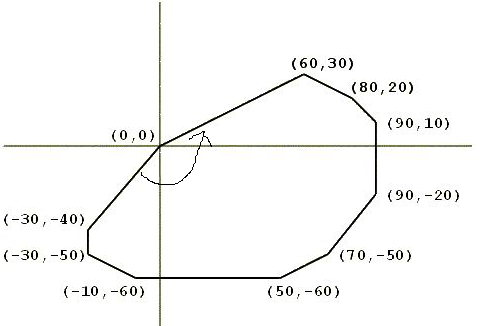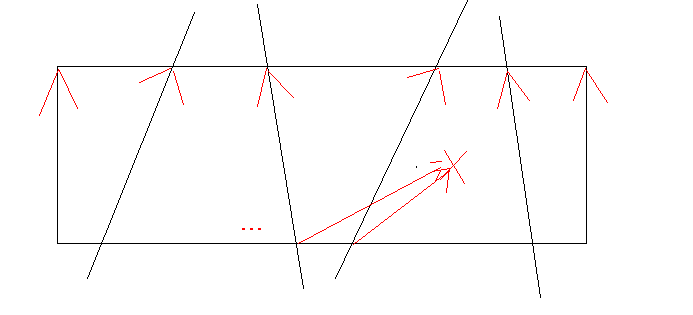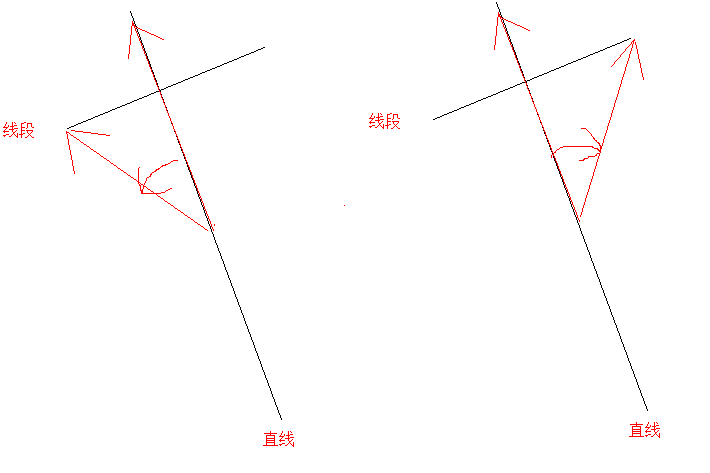
前置知识
向量叉积,两个向量的形式,这里的 PII 为一个向量
#define PII pair<int, int>
#define x first
#define y second
int cross(PII A, PII B) {// vector(A) * vector(B)
return A.x * B.y - B.x * A.y;
}
三个点的形式,OA向量 叉乘 OB向量,这里 PII 为点
#define PII pair<int, int>
#define x first
#define y second
int area(PII o, PII a, PII b) {// vector(OA) * vector(OB)
PII A = {a.x - o.x, a.y - o.y};
PII B = {b.x - o.x, b.y - o.y};
return cross(A, B);
}
A
以最小 y 的点为原点,用叉积进行排序,保证相邻两个点的叉积 >0,中间那个点和原点的连线就是题目需要的
#include <bits/stdc++.h>
using namespace std;
#define int long long
#define rep(i, l, r) for(int i = l; i <= (int)r; i ++)
#define PII pair<int, int>
const int N = 2e5 + 5;
#define x first
#define y second
int n;
struct Point {
PII p;
int id;
} o[N];
int cross(PII A, PII B) {// vector(A) * vector(B)
return A.x * B.y - B.x * A.y;
}
int area(PII o, PII a, PII b) {// vector(OA) * vector(OB)
PII A = {a.x - o.x, a.y - o.y};
PII B = {b.x - o.x, b.y - o.y};
return cross(A, B);
}
void solve() {
cin >> n;
if(n & 1) {
cout << "-1 -1\n";
} else {
int miny = 1e9, minid;
rep(i, 1, n) {
int x, y;
cin >> x >> y;
o[i] = {{x, y}, i};
if(y < miny) miny = y, minid = i;
}
swap(o[1], o[minid]);
sort(o + 2, o + 1 + n, [&] (Point &A, Point &B) {
return area(o[1].p, A.p, B.p) > 0;
});
cout << o[1].id << " " << o[n / 2 + 1].id << '\n';
}
}
main() {
ios::sync_with_stdio(false);
cin.tie(0); cout.tie(0);
int _ = 1;
// cin >> _;
while(_ --) {
solve();
}
return 0;
}
B
让点按这个顺序输出

连接原点和各点,就是让相邻的向量叉积 >0
#include <iostream>
#include <algorithm>
using namespace std;
#define int long long
#define rep(i, l, r) for(int i = l; i <= (int)r; i ++)
#define PII pair<int, int>
const int N = 2e5 + 5;
#define x first
#define y second
int n = 1;
PII o[N];
int cross(PII A, PII B) {// vector(A) * vector(B)
return A.x * B.y - B.x * A.y;
}
int area(PII o, PII a, PII b) {// vector(OA) * vector(OB)
// PII A = {a.x - o.x, a.y - o.y};
// PII B = {b.x - o.x, b.y - o.y};
PII A, B;
A.x = a.x - o.x, A.y = a.y - o.y;
B.x = b.x - o.x, B.y = b.y - o.y;
return cross(A, B);
}
bool cmp(PII A, PII B) {
return area(o[1], A, B) > 0;
}
void solve() {
while(cin >> o[n].x >> o[n].y) n ++;
n --;
sort(o + 2, o + 1 + n, cmp);
for(int i = 1; i <= n; i ++) {
cout << "(";
cout << o[i].x << "," << o[i].y;
cout << ")\n";
}
}
main() {
ios::sync_with_stdio(false);
cin.tie(0); cout.tie(0);
int _ = 1;
// cin >> _;
while(_ --) {
solve();
}
return 0;
}
C
点在三角形内,等价这三对向量叉乘的符号相同,在线上用两点距离判断

#include <bits/stdc++.h>
using namespace std;
#define rep(i, l, r) for(int i = l; i <= (int)r; i ++)
#define PII pair<int, int>
const int N = 2e5 + 5;
#define x first
#define y second
const double eps = 1e-5;
int x[N], y[N];
int sign(int x) {
if(x > 0) return 1;
if(x < 0) return -1;
return 0;
}
int cross(PII A, PII B) {// vector(A) * vector(B)
return A.x * B.y - B.x * A.y;
}
int area(PII o, PII a, PII b) {// vector(OA) * vector(OB)
PII A = {a.x - o.x, a.y - o.y};
PII B = {b.x - o.x, b.y - o.y};
return sign(cross(A, B));
}
double dist(PII A, PII B) {
int dx = A.x - B.x;
int dy = A.y - B.y;
return sqrt(dx * dx + dy * dy);
}
int solve() {
rep(i, 1, 4) scanf(" (%d,%d)", &x[i], &y[i]);
// rep(i, 1, 4) cout << x[i] << " " << y[i] << '\n';
rep(i, 1, 3) if(x[i] == x[4] && y[i] == y[4]) return 4;
PII C = {x[4], y[4]};
bool pos = false, neg = false;
rep(i, 1, 3) {
int j = i + 1;
if(j == 4) j = 1;
PII A = {x[i], y[i]}, B = {x[j], y[j]};
int t = area(A, B, C);
if(dist(A, C) + dist(B, C) - dist(A, B) < eps) return 3;
if(t > 0) pos = true;
if(t < 0) neg = true;
}
if(pos && neg) return 2;
return 1;
}
main() {
// ios::sync_with_stdio(false);
// cin.tie(0); cout.tie(0);
int _ = 1;
// cin >> _;
while(_ --) {
cout << solve();
}
return 0;
}
D
两点确定一条直线,枚举所有直线,另外一个点也在这条线上可以用向量叉积,叉积为0说明在同一直线
#include <bits/stdc++.h>
using namespace std;
#define rep(i, l, r) for(int i = l; i <= (int)r; i ++)
#define PII pair<int, int>
const int N = 2e5 + 5;
#define x first
#define y second
int n;
PII p[N];
int cross(PII A, PII B) {// vector(A) * vector(B)
return A.x * B.y - B.x * A.y;
}
int area(PII o, PII a, PII b) {// vector(OA) * vector(OB)
PII A = {a.x - o.x, a.y - o.y};
PII B = {b.x - o.x, b.y - o.y};
return cross(A, B);
}
void solve() {
cin >> n;
rep(i, 1, n) {
int x, y;
cin >> x >> y;
p[i] = {x, y};
}
int qwq = 0;
for(int i = 1; i <= n; i ++) {
for(int j = i + 1; j <= n; j ++) {
int cnt = 0;
PII A = p[i], B = p[j];
for(int k = 1; k <= n; k ++) {
if(k == i || k == j) continue;
PII C = p[k];
if(area(A, B, C) == 0) cnt ++;
}
qwq = max(qwq, cnt + 2);
}
}
cout << qwq << '\n';
}
main() {
ios::sync_with_stdio(false);
cin.tie(0); cout.tie(0);
int _ = 1;
// cin >> _;
while(_ --) {
solve();
}
return 0;
}
D
每个点都在左侧向量的右侧,右侧向量的左侧,叉乘后符号不同,满足两段性,可以二分

#include <iostream>
#include <cstring>
using namespace std;
#define int long long
#define rep(i, l, r) for(int i = l; i <= (int)r; i ++)
#define PII pair<int, int>
const int N = 2e5 + 5;
#define x first
#define y second
int n, m;
PII up[N], down[N];
int ans[N];
int cross(PII A, PII B) {// A * B
return A.x * B.y - B.x * A.y;
}
int area(PII o, PII a, PII b) {// OA * OB
// PII A = {a.x - o.x, a.y - o.y};
// PII B = {b.x - o.x, b.y - o.y};
PII A, B;
A.x = a.x - o.x, A.y = a.y - o.y;
B.x = b.x - o.x, B.y = b.y - o.y;
return cross(A, B);
}
bool check(int mid, int x, int y) {
PII o = down[mid];
PII a = up[mid];
// PII b = {x, y};
PII b;
b.x = x, b.y = y;
return area(o, a, b) < 0;
}
int find(int x, int y) {
int l = 0, r = n;
while(l < r) {
int mid = l + r + 1 >> 1;
if(check(mid, x, y))
l = mid;
else
r = mid - 1;
}
return l;
}
void solve() {
bool is_first = true;
while(cin >> n && n) {
int x1, y1, x2, y2;
cin >> m >> x1 >> y1 >> x2 >> y2;
// up[0] = {x1, y1}, down[0] = {x1, y2};
up[0].x = x1, up[0].y = y1;
down[0].x = x1, down[0].y = y2;
for(int i = 1; i <= n; i ++) {
int u, l;
cin >> u >> l;
// up[i] = {u, y1};
// down[i] = {l, y2};
up[i].x = u, up[i].y = y1;
down[i].x = l, down[i].y = y2;
}
memset(ans, 0, sizeof ans);
while(m --) {
int x, y;
cin >> x >> y;
ans[find(x, y)] ++;
}
if(is_first) is_first = false;
else cout << '\n';
for(int i = 0; i <= n; i ++) {
cout << i << ": ";
cout << ans[i] << '\n';
}
}
}
main() {
ios::sync_with_stdio(false);
cin.tie(0); cout.tie(0);
int _ = 1;
// cin >> _;
while(_ --) {
solve();
}
return 0;
}
D
如果存在这样的直线,将直线旋转,这条会卡在线段的端点,所以可以枚举这两个端点
,形成一条直线,然后检查这条直线是否穿过其它所有线段

如果穿过,则这两个向量叉积符号相反
#include <iostream>
#include <cmath>
using namespace std;
#define int long long
#define rep(i, l, r) for(int i = l; i <= (int)r; i ++)
#define pb push_back
const int N = 2e5 + 5;
#define x first
#define y second
#define PDD pair<double, double>
const double eps = 1e-8;
int n;
PDD a[N], b[N], p[N];
bool is__same(PDD A, PDD B) {
return fabs(A.x - B.x) < eps && fabs(A.y - B.y) < eps;
}
double cross(PDD A, PDD B) {// vector(A) * vector(B)
return A.x * B.y - B.x * A.y;
}
double area(PDD o, PDD a, PDD b) {// vector(OA) * vector(OB)
// PDD A = {a.x - o.x, a.y - o.y};
// PDD B = {b.x - o.x, b.y - o.y};
PDD A, B;
A.x = a.x - o.x, A.y = a.y - o.y;
B.x = b.x - o.x, B.y = b.y - o.y;
return cross(A, B);
}
int sign(double x) {
if(fabs(x) < eps) return 0;
if(x < 0) return -1;
if(x > 0) return 1;
}
bool check() {
for(int i = 1; i <= 2 * n; i ++) {
for(int j = i + 1; j <= 2 * n; j ++) {
if(is__same(p[i], p[j])) continue;
bool ok = true;
for(int k = 1; k <= n; k ++) {
if(sign(area(p[i], p[j], a[k])) * sign(area(p[i], p[j], b[k])) > 0) {
ok = false;
break;
}
}
if(ok) return true;
}
}
return false;
}
void solve() {
cin >> n;
for(int i = 1, k = 1; i <= n; i ++) {
double x1, y1, x2, y2;
cin >> x1 >> y1 >> x2 >> y2;
// a[i] = {x1, y1}, b[i] = {x2, y2};
a[i].x = x1, a[i].y = y1;
b[i].x = x2, b[i].y = y2;
// p[k ++] = {x1, y1};
p[k].x = x1, p[k ++].y = y1;
// p[k ++] = {x2, y2};
p[k].x = x2, p[k ++].y = y2;
}
cout << (check() ? "Yes!\n" : "No!\n");
}
main() {
ios::sync_with_stdio(false);
cin.tie(0); cout.tie(0);
int _ = 1;
cin >> _;
while(_ --) {
solve();
}
return 0;
}

